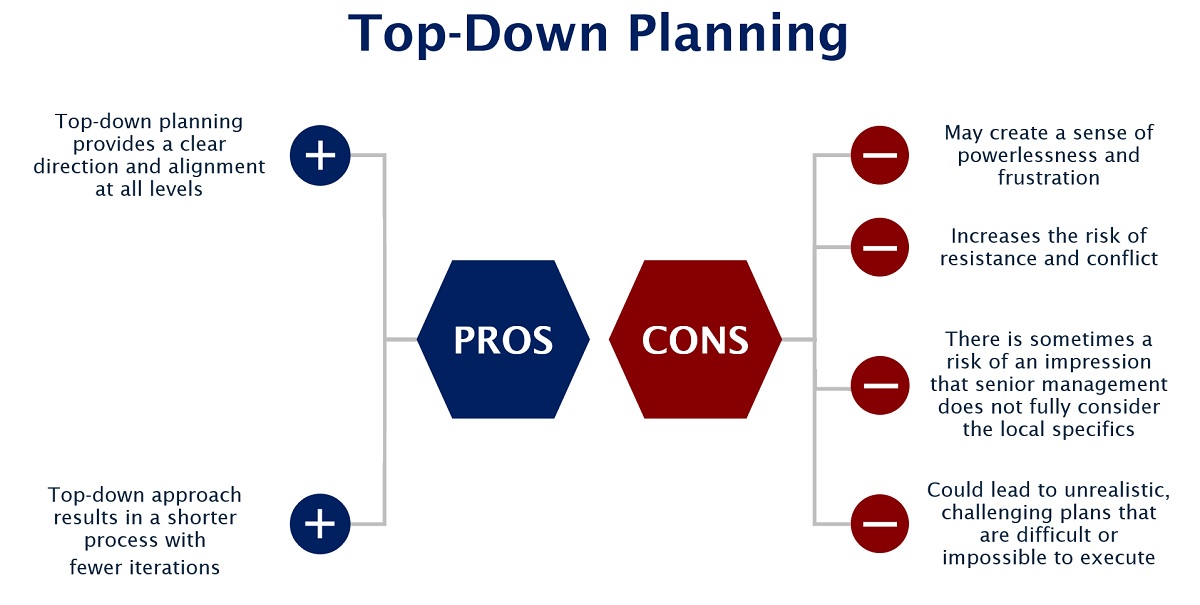Here are some practical Business Partnering strategies and tips from the author's experience. They will help...

Planning is a never-ending process: once one stage is finished, the next begins. It is very well-known for all of us. Every year, most companies face that unavoidable, usually pretty long and often energy-stealing budgeting process. Similarly, every year, we deal with the same question: top-down or bottom-up? What is better, and what is more efficient?
Let's examine these two most often-used planning approaches and validate their pros and cons.
Planning is crucial for setting goals, allocating resources and coordinating actions to achieve desired outcomes aligned with the company's strategy. Indeed, to ensure that the organisation is moving in the right direction, we should clearly outline the expectations and accept the focus areas at all levels. Also, the approach to the planning process often mirrors the company's situation and culture.
While some companies focus on enablement and empowerment, allowing time for multiple cycles of discussions and process iterations (bottom-up approach), others prefer more directive guidelines with stricter and more structured processes (top-down approach).
Both planning approaches have advantages and disadvantages, depending on the status of the organisation. Sometimes, companies decide to combine both budgeting approaches to get the best possible outcome. So, let's deep dive into some details.
Top-Down Planning
Top-down planning is an approach that starts with the corporate vision and mission and then cascades down the targets to the lower levels of the organisation. It is often associated with a centralised and formalised structure. This planning method follows a logical and sequential process, where the plans are derived from the higher-level objectives and then broken down into smaller and more specific expectations, often high-level only.
Pros of Top-Down Planning
- Top-down planning provides a clear direction and alignment at all levels. By starting with the big picture and then cascading down to the lower levels, top-down planning ensures that the plans are coherent and consistent with the organisation's purpose and values. It enhances the efficiency and effectiveness of the planning process.
- Very often, the top-down approach results in a shorter process with fewer iterations, as the expectations are clear from the beginning.
Cons
- Due to a centralised and authoritative structure, top-down planning may create a sense of powerlessness and frustration among the employees and stakeholders. This may lead to a loss of trust and cooperation within the business.
- This approach often increases the risk of resistance and conflict within the organisation.
- In top-down planning, there is sometimes a risk of an impression that senior management does not fully consider the local specifics and may not have a realistic and accurate understanding of the organisation's capabilities and constraints due to this.
- Also, top-down planning could lead to unrealistic, challenging plans that are difficult or impossible to execute. In turn, it can result in a lack of commitment and motivation among the subordinates, as they may feel not being involved in the process.

Figure 1: Pros and Cons of Top-Down Planning
Recommendations
Considering the above, the top-down planning is recommended to be deployed where:
- the organisation faces a stable and predictable environment,
- the long-term goals are clear and consistent,
- the strict coordination and control of activities are important.
Top-down planning should be combined with extended, intensive and clear communication within the organisation, including sharing the purpose and details behind the targets.
Another important factor is to have a 'listening tour' inside your company right after the targets are shared. It can help to ensure that the teams can share their thoughts openly and provide valuable insights.
Transparency of organisational targets, including benchmarks of goals, is also crucial. This will give employees the feeling of fairness and trust and increase the target's acceptance level.
As the top-down targets are usually high-level, it is important to deliver value in the 'how we can make it happen' role. This will imply work that includes splitting targets into detailed data, considering the business areas' contributions, seasonality trends, validation of possible scenarios in different departments, and so on.
Bottom-up Planning
Bottom-up planning is a participatory approach that involves the input and feedback from different departments and stakeholders in the planning process.
It is often associated with a decentralised and flexible structure, where the employees have more autonomy and empowerment to contribute to decision-making. This approach is based on the assumption that the local teams and stakeholders have the best knowledge and information about the organisation's capabilities, constraints, problems, and opportunities. Therefore, they are best positioned to contribute and participate in the planning process. Bottom-up planning follows a collaborative and iterative process, where the plans are derived from the input and feedback of the lower levels of the organisation and then integrated and aligned with the higher-level objectives.
Bottom-up planning is often used when an organisation faces a dynamic and quickly changing environment.
Pros
- Because of its flexible and participatory structure, bottom-up planning encourages the input and feedback of the local teams and stakeholders, who may have diverse and novel insights about the organisation's problems and opportunities.
- In this approach, senior management can have a realistic and accurate understanding of the organisation's capabilities and constraints, as they are in touch with the operational realities and challenges. This can facilitate realistic and practical plans that are feasible to execute. It may also result in high commitment and motivation among the subordinates, as they feel involved and valued in the planning process.
- It improves collaboration in the organisation, resulting in stronger cooperation and a supportive culture setting.
Cons
- By starting with the lower-level input and feedback and then integrating them with the higher-level objectives, bottom-up planning may take a lot of time and even lead to confusion and inconsistency. It may compromise the direction and alignment of the organisation's vision, mission, and goals.
- If incentive schemes are strongly linked to the budget data, bottom-up planning could include bias about possible future performance optimisation.
- It may reduce the efficiency and effectiveness of the planning process and increase its complexity. Furthermore, it may also hinder the allocation and utilisation of resources, as senior management may not be able to prioritise and distribute them according to the strategic objectives.
Another challenge of bottom-up planning is compromising long-term planning. This may affect the continuation of the direction of the organisation, as the employees may focus more on the short-term and immediate needs rather than the long-term and strategic ones.

Figure 2: Pros and Cons of Bottom-Up Planning
Recommendations
The outcome of the bottom-up planning should not be a surprise. It is important to have clear, shared and aligned long-term objectives.
Local teams should base their bottom-up plans on previously discussed directional trends. These plans should reflect the understanding of the strategic guidance and goals. Consistency and continuity in the organisation's direction are also crucial.
Balancing the best of two approaches is vital for achieving better results. For instance, we can combine setting clear and shared objectives, providing strategic guidance and direction, alignment and coordination across the organisation with consistency and continuity in the company's direction not only during the budgeting process but also during the year.
Businesses may also consider detaching the incentive plans from budgeting data or keeping them very high level. This will allow a more reliable and cooperative bottom-up process.
Sometimes, bottom-up planning outcomes can be used as a starting point for the next planning process and can become a basis for discussing and preparing for the top-down target-setting phase.
One more possibility for a smoother budgeting process can be a rolling outlook approach for 12 months, where the evolution is regularly monitored and understood during the year, and the budgeting then logically provides a clear outcome.
We don't have to forget about the importance of new technologies, which can be used to balance and combine both planning approaches. Using systems and different categories, we can do both planning methods simultaneously as top-down and bottom-up and then run the analytics and comparisons to support the discussions and alignment.
Utilisation of Machine Learning/Artificial Intelligence(ML/AI)-powered planning is another chapter, and we can talk about it in the next article.
Conclusion
Both approaches have unique advantages and disadvantages. The top-down approach provides clear direction and organisational alignment at all levels, enhancing the efficiency and effectiveness of the planning process. However, it may create a sense of powerlessness and frustration among employees and stakeholders, leading to poorer cooperation and loss of motivation within the company.
On the other hand, bottom-up planning encourages input and feedback from lower-level employees and stakeholders, improving cooperation and collaboration. Conversely, it may create confusion and inconsistency, compromising the direction and alignment of the organisation's vision, mission, and goals.
Therefore, the best solution may be to combine both methods and leverage their strengths while mitigating their weaknesses. By balancing top-down and bottom-up planning, organisations can improve efficiency and effectiveness and achieve a greater sense of ownership and engagement among the employees. We should not underestimate that in both planning approaches, clear communication, knowledge exchange, trust, and transparency are the critical success factors.
Subscribe to
FP&A Trends Digest

We will regularly update you on the latest trends and developments in FP&A. Take the opportunity to have articles written by finance thought leaders delivered directly to your inbox; watch compelling webinars; connect with like-minded professionals; and become a part of our global community.






